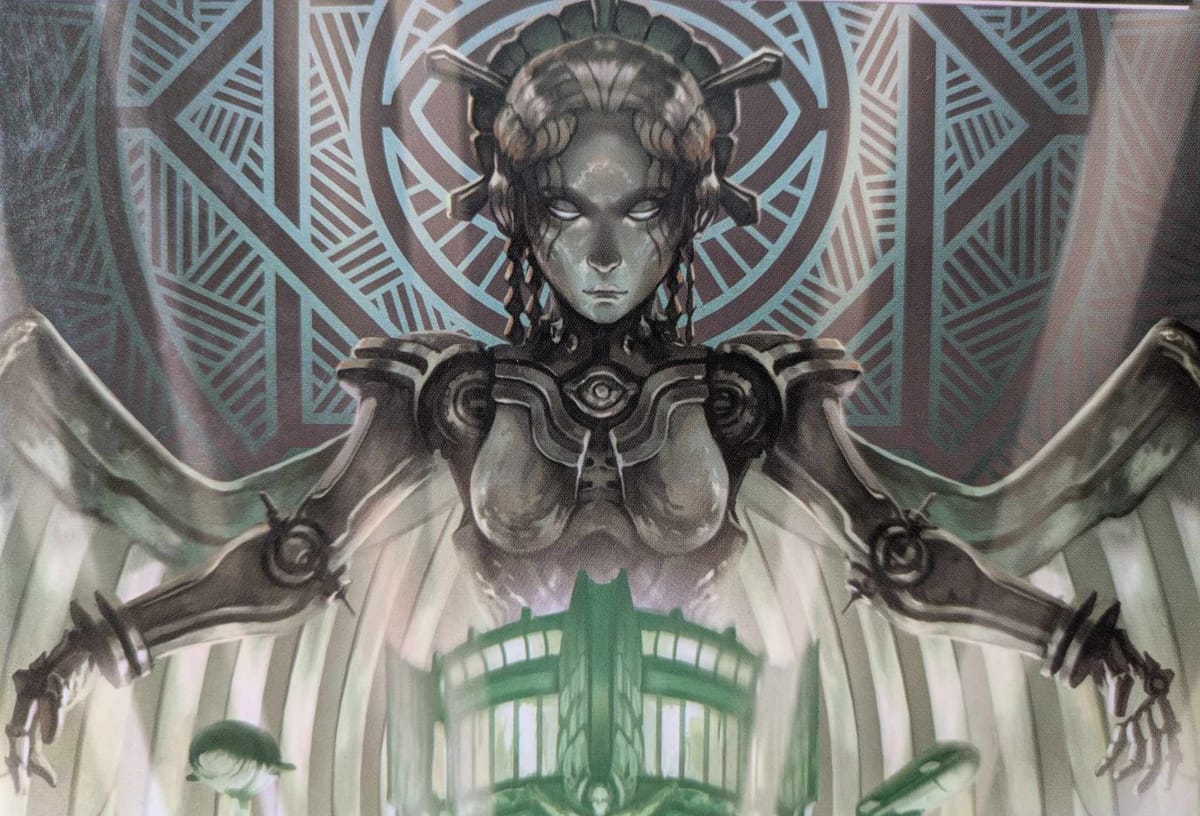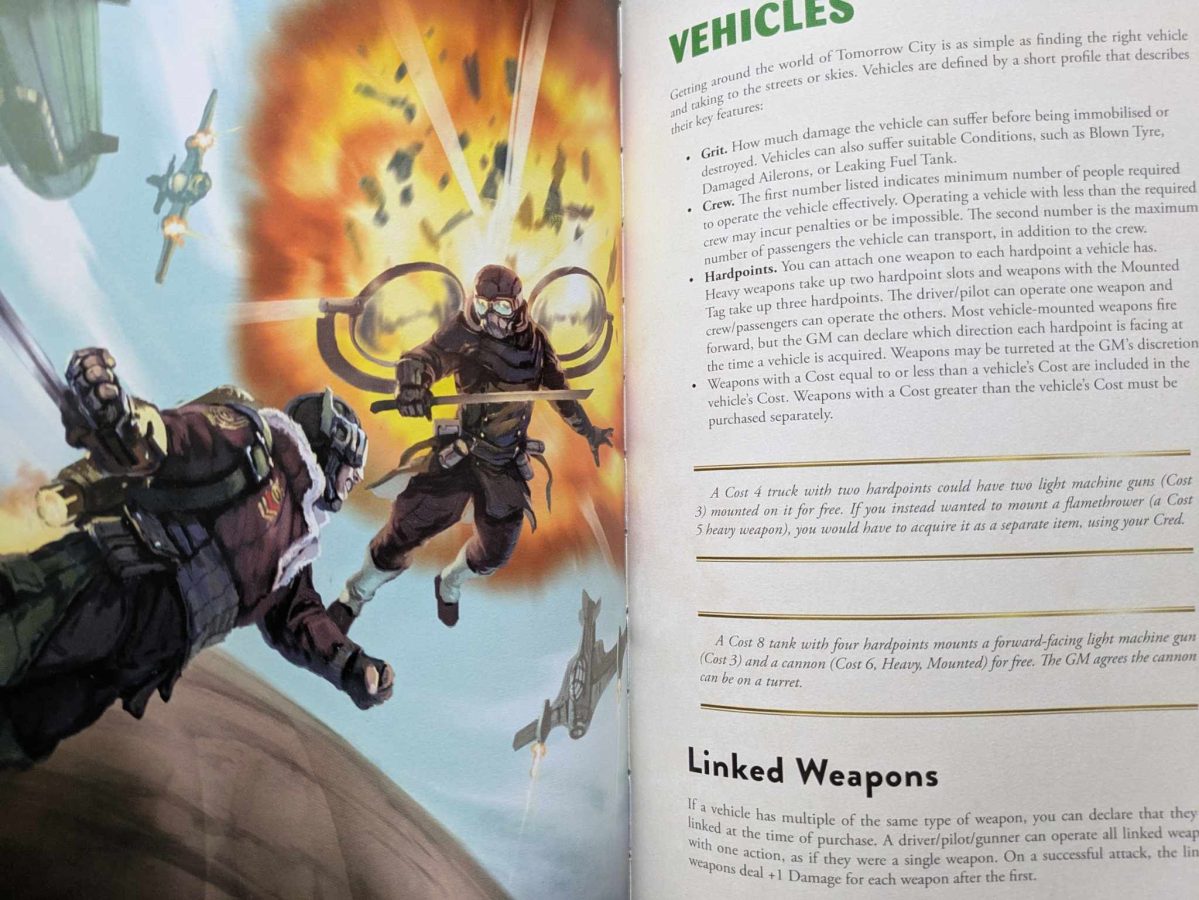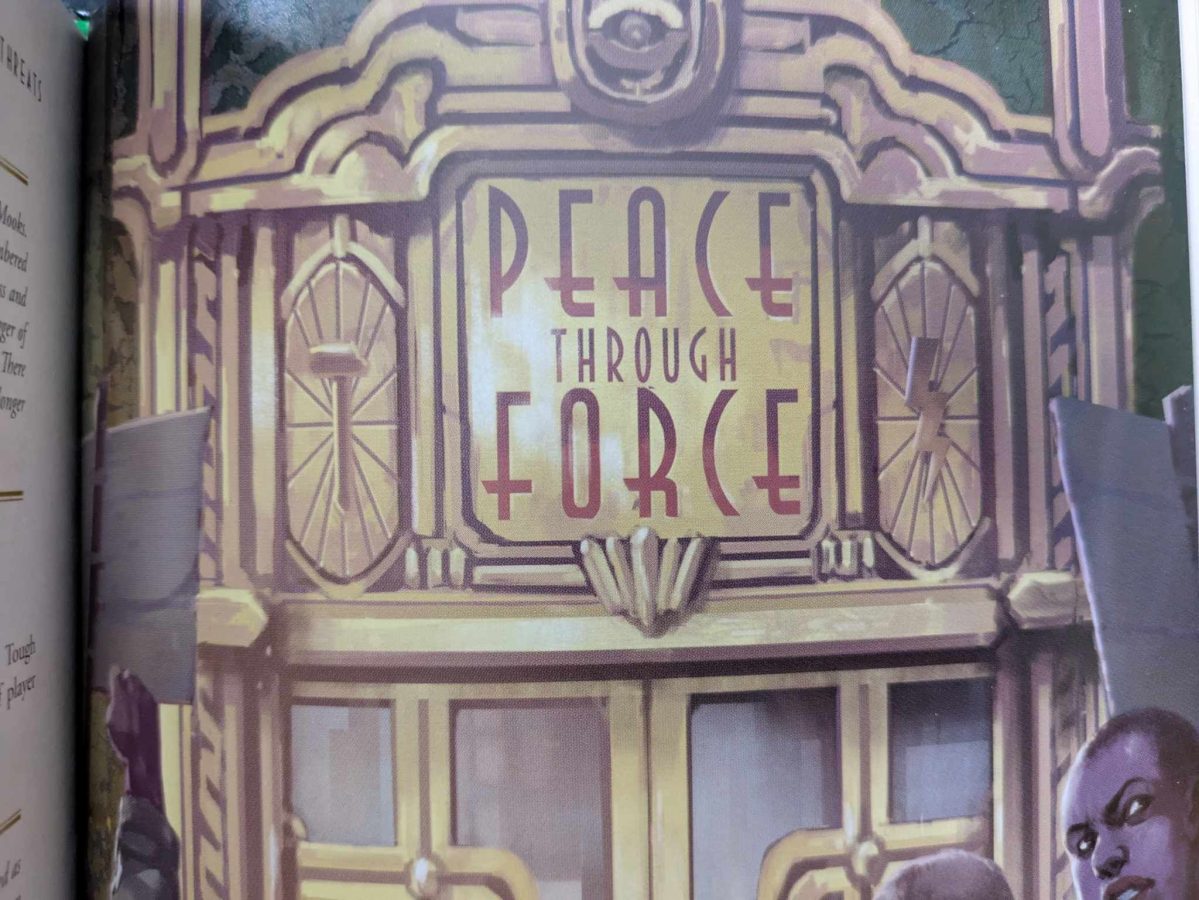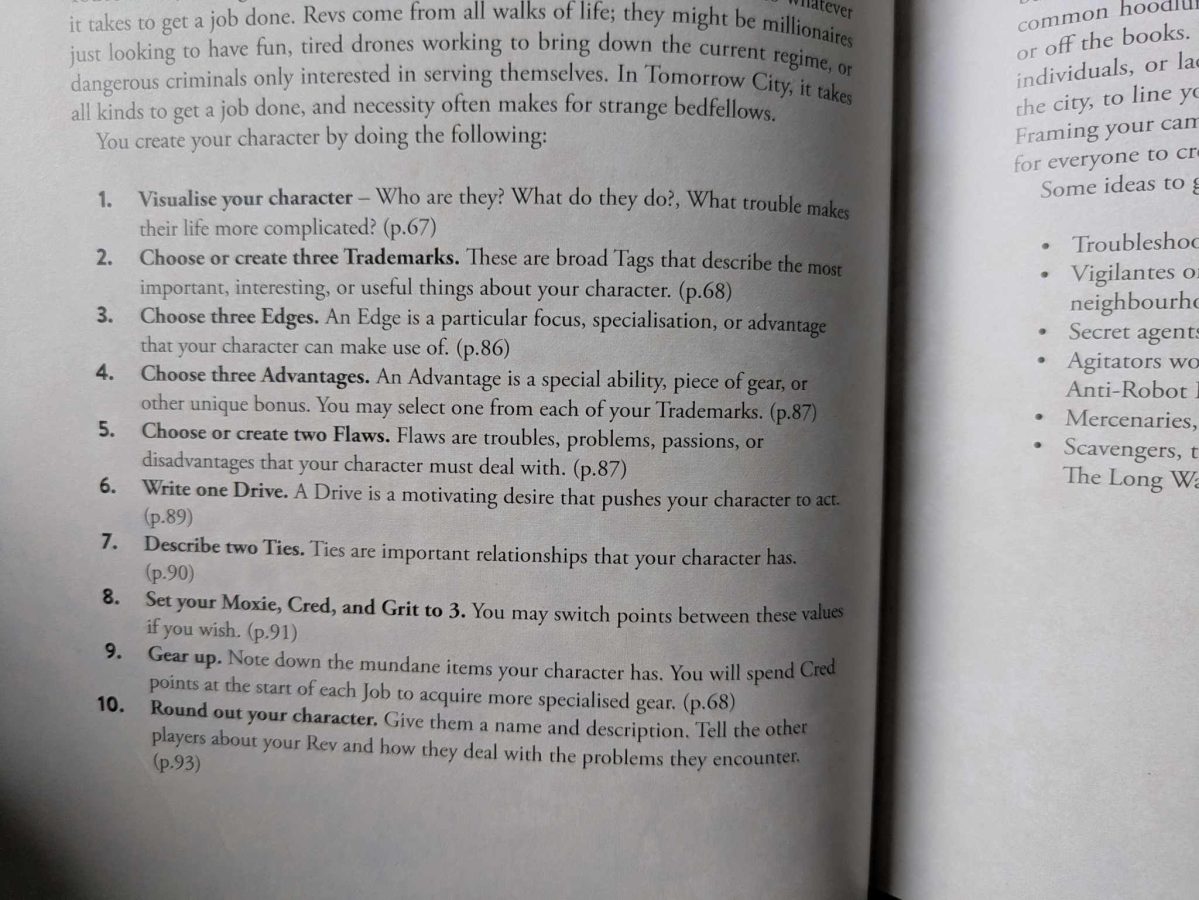
It’s 1984 and the world is in shambles. Decades of conflict have wrought their ruin, and Tomorrow City’s art-deco splendor looms over the land, its many rings grinding lives down into constituent parts for the great machine. Tomorrow City’s Dieselpunk revolution opens with a bang that the rest of the book knows how to deliver on. A mid-weight game and text, its staying power may wane with longer games, but its mechanics, themes, and organization ensure a low learning curve for a game that had plenty of meat to it for short to mid-length campaigns. Paying more than lip service to Metropolis and Dark City, this game conveys both the aesthetics and the greater themes of oppressive, industrial landscapes and the people fighting for freedom within them. After my recent reviews of games with meandering texts and obtuse organization, Tomorrow City felt like a wondrous return to form; it’s clear that Nathan Russell has a firm grasp of how to conceptualize and communicate a great RPG.
At 224 pages, this smaller than average tome is quite reasonable for its $35 price tag. Durable and stylish, its art and layout may not be the pinnacle of the genre, but they know how to communicate tone and mechanics quite well. My one complaint is that, similar to Osprey Game’s Crescendo of Violence, they could have eaten up more of the page space with text. The blank space on various sides could have been better served with larger text font, but that’s not to say it’s actually bad or awkward while reading.

Most impressive is Tomorrow City’s organization. There is no index, but the table of contents is far more comprehensive than average; navigation is a breeze even without that resource, as you get a logical flow from influences to setting to character creation and mechanics and GM resources. Information is generally right where you think it would be, and laid out so that it’s easy to grasp moment to moment. A quick introduction gives you a workable understanding of the setting’s major themes, conflicts, timeline, factions, individuals, and districts. All delivered with good bolding and concise explanations, this is a good tool at the table or during your initial readthrough. Pages 10-11 have no meandering introspection about genre. They’re a tight, clear delivery of what this game is about and what you can expect from it: Survival. War. Science. Got it. With little elaboration I know exactly what this book is trying to convey and what you can expect during games.
That setting is familiar but fresh, melding industrial decoration with post-modern paranoia. Mother, the mechanical-brained matriarch, runs the city via the Ministries of Truth, Peace, and Science. Mad science runs as rampant as the robots that are threatening a human workforce, all while the world itself is being corrupted by supernatural energies. Along the way you have various secret societies turning things on their head and fighting for power. These factions all have a great touch in the form of internal conflicts: disagreements about their goals or methods that will form a useful wedge for authority figures or player characters. Those characters take the form of Revs, revolutionaries striving to change the system, or come out on top.

Tomorrow City’s base mechanics are simple, but make room for nuance as you get into them. Any task will require you to roll at least two six sided dice, one for Action and the other Danger. You’ll need a way to differentiate these, ideally with multiple colors. If not you will have to be careful about separating die types. Other elements will add dice of either color. After rolling, any matching dice between Action and Danger cancel out, and you take the highest remaining action die as your roll. A value of 6 is an outright success, with more adding Boons, or positive benefits. 4-5 is a partial success and 3 or less is a failure. If the only remaining dice show 1s, you Botch the roll, effectively a critical failure.
If you have any leftover Danger Dice reading 6, you build Pressure. Starting at 0, Pressure accumulates during scenes and triggers at 6, causing the situation to escalate. Maybe something breaks down or guards enter, this adds weight to every roll by adding a ticking clock to every scene. It’s a great mechanic, and one that extends just as well to combat as it does to social encounters or exploration.
The base mechanic and Pressure are bolstered by a few twists. Characters have Masteries, which allow them to reroll under situational circumstances, but mostly they are subject to the ever-present concept of Tags. Tags attach to everything. Characters, objects, locations all come with Tags which Boons or Botches can add or remove. They cover general qualities (guns are Loud, fixers are Shady, et cetera) describing both what something is capable of and how it affects a situation. Generally this comes in the form of allowing/disallowing actions or adding action and danger dice.

There is good and bad to the Tags at work here. For the good, they’re a quick way to communicate to the players and GM. Any NPC or object will have a few immediate, readable tags to let you know important information. They are also easy to mechanize: Tags are tradable, and either describe something or add/remove d6s. Similar to the bonuses and penalties of other games, they make for a good shorthand that comes with clear mechanical weight. I’ve seen similar concepts applied less aptly in other contexts (Technoir comes to mind) and they are a good way to make for shorthand and get the game’s mechanical economy running.
This simplicity does come with some drawbacks, of course. For one, what exactly constitutes a Tag, and what is a general quality of a thing? I understand that a gun is loud, and usually wouldn’t feel the need to mechanize that. What quality needs to be mechanized in that way? Additionally, Tags are limited in how similar they are. They perform a few specific functions and nothing else. From a strict mechanical perspective, a room being on fire or slippery or anything else rounds out to the same thing. I haven’t played Tomorrow City for a long time, but I can see it getting samey over time as everything amounts to plus or minus some d6s. Also while not strictly necessary, I would like to see a game this focussed on one mechanic, spend time discussing how the math works out. As my players accumulate Action and Danger, it would be nice to have an idea of how that communicates to chances of success or failure. It’s one mechanic that we’ll be seeing a lot of, after all.
I don’t need to explain character creation, because the book adequately does that on its own. Gander if you will at page 66 below. You see that? You see how everything is laid out concisely in a single page with direct references to all of the information you’ll need for the other steps? This is how you deliver information in an RPG book. Not several pages of meandering, nonsense text. A list of the steps you need to make your character. RPG sourcebooks have plenty of story and visuals but for the sake of all that’s holy, they are also rulebooks. They are technical manuals, and obscuring rules is a waste of time and effort by the author on behalf of the player. Thank you Nathan, I was starting to go insane. There is no excuse for doing worse than this. If you can’t break down character creation, indeed the base mechanics to your game as a whole, into a concise, useful summary, you have no business writing any RPG.
 While most things are adequately explained by the page above, I can go into detail on a few other areas. Moxie are meta-points used to fuel powers or special advantages. Trademarks, in the form of backgrounds, descriptors, occupations, and pattern weavers (supernatural), give you optional edges that add to your Action pool where applicable. Advantages are special abilities or powers. Drives and Ties are your goals and relationships, that will move plots forward and give you a grounding in the setting. Cred represents resources, both monetary and relational, that you can use to get Gear. Gear comes with bonuses and penalties of its own so you can weigh what you want to bring on a given job.
While most things are adequately explained by the page above, I can go into detail on a few other areas. Moxie are meta-points used to fuel powers or special advantages. Trademarks, in the form of backgrounds, descriptors, occupations, and pattern weavers (supernatural), give you optional edges that add to your Action pool where applicable. Advantages are special abilities or powers. Drives and Ties are your goals and relationships, that will move plots forward and give you a grounding in the setting. Cred represents resources, both monetary and relational, that you can use to get Gear. Gear comes with bonuses and penalties of its own so you can weigh what you want to bring on a given job.
Characters can take Harm equal to their Grit value, and further harm cause Injuries, which have their own small tracks for Harm. You can take Injuries up to your Grit value, and start dying when all are full of their Harm. Injuries recover more slowly than Harm loss, but a maxed Injury becomes a Trauma that can only be healed between adventures with proper treatment. You can also receive negative Conditions that affect your ability to operate, such as the typical Poison or Stunned, though you are free to make your own.
As you may be able to tell, characters offer many freeform options. Tomorrow City doesn’t have a locked down skill list or set of classes, and it will be up to you to determine who your characters are and how they operate. The system takes general character traits and gives you a few distinct ways to mechanize them, as it broadly does with objects and locations and NPCs.
The game also features subsystems which are numerous but not deeply developed. That’s not to say they’re bad or overly simplistic exactly. Like the game as a whole, they’re well organized and approachable, but will need you to move through them rather than rest on any one for an extended length of time. These systems cover chases, social interactions, building and maintaining robots, interrogations, chases, dog-fights, and down time. All are very fitting to the dieselpunk world of Tomorrow City while offering you an appreciable variety of experiences.

The advancement system has a particularly interesting quirk, influenced by the course of your adventure. Your character sheet has 10 boxes that you mark over time. Every 5 ticks nets you a new Trademark and every 10 allows you to get a new Edge/Advantage or increase Cred, Grit, or Moxie. However, you check boxes positively for good experiences/sessions and negatively for bad ones. If you come out of a job with more bad than good, you start the next adventure with lower Moxie and 1-3 conditions attached, showing how your experiences wear on you over time. Weighing against the benefits of healing and advancement, I like this quite a bit. Your character doesn’t get a total reset with some time, and may have difficulty coming back to reality after a particularly troubling mission. It’s a great way to show the physical and psychological effect of adventuring without really crippling your character.
The book continues with a brief but captivating adventure, which sees you interacting with the local authorities and seeing some of Tomorrow City’s more fantastical sights. At the end is a nice series of Appendices which summarize important information and give you resources like generating random jobs or hooks.
Tomorrow City’s general lack of complexity is not strictly a drawback. It has enough weight to it that you can navigate a variety of subsystems and make characters that are meaningfully distinct. There is some granularity lost with its generalized system, but not the kind that renders the affair handwaivy. There are enough rules to get you where you need to go, but whether they carry the kind of game you want to play is more a matter of personal preference.
Tomorrow City
Great
Tomorrow City is a thematic, economical package with a lot to enjoy about its system and presentation. Its stellar organization makes it easy to approach and get your head around, while the underlying rules have enough variety to support a lot of play. While some of the simplifications threaten its viability for longer games, Tomorrow City strikes its own way depicting a dieselpunk city with plenty of mystery, intrigue, and adventure.
Pros
- Layout and organization make it a breeze to learn
- A great implementation of dieselpunk visuals and themes
- Features a good array of alternate systems
Cons
- Characters lack mechanical granularity
- Tags raise some questions about application
- Small size makes it economical and easy to transport, but impacts readability
